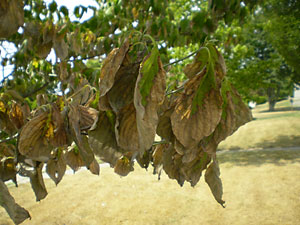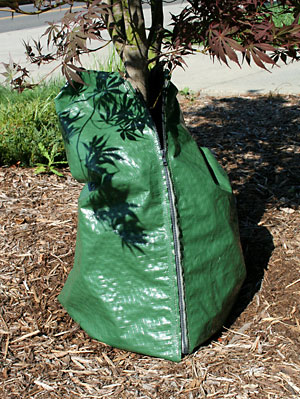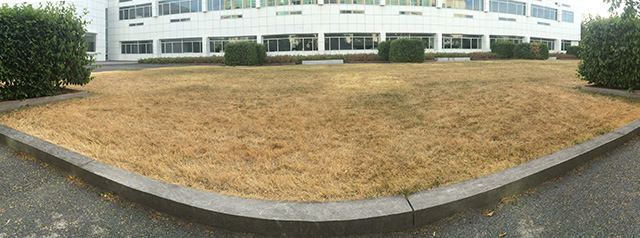
Despite some welcome rains yesterday (July 25), much of central and western New York remains in a severe drought.
The combination of low snowfall last winter and meager rainfall and warm temperatures this season has reduced stream flows to a trickle, ruined crops and scorched many landscapes this summer.
So, according to Cornell scientists, what’s your best bet to save your grass, trees and shrubs?
Water your trees and shrubs, but not the lawn.
“Overwatering during hot weather does far more damage to a lawn than drought,” says Frank Rossi, turf specialist in the Horticulture Section of Cornell University’s School of Integrative Plant Science. Watering – particularly frequent light watering – encourages lawn diseases and weeds, he explains.
The cool-season lawn grasses commonly grown in the region naturally slow down as temperatures rise and soil moisture decreases, even in normal summers, notes Rossi. When it’s hot and dry, he suggests just letting the lawn go completely dormant.
“Think of your lawn like a hibernating bear,” he suggests. “Many lawns will turn completely brown. But most of the lawn grasses will survive 4 to 6 weeks without significant rainfall.” In most cases, they’ll green up again in late summer or early fall when the rain returns and the temperatures moderate.
But that’s not the case with trees and shrubs, says Nina Bassuk, director of the Urban Horticulture Institute in Cornell’s Horticulture Section. “When it’s really hot and dry, many trees and shrubs will shed their leaves – and some will just dry up. Drought is very stressful and can sometimes kill them outright,” she points out.
Newly planted trees and shrubs are particularly vulnerable because their root systems aren’t fully developed. They have a harder time foraging for moisture, warns Bassuk. Depending on the species, site and planting practices, that might mean keeping two- to five-year-old plantings carefully watered during dry periods, hopefully preventing drought-caused leaf damage or loss in the first place.
But don’t give up on trees and shrubs that have shed their leaves, says Bassuk. “Go ahead and water them,” she suggests. “It’s better late than never. If they’re still alive, they’ll grow new leaves. And after two weeks of photosynthesizing they’ll have made up for the extra effort it took them to re-leaf.” Any extra energy the leaves gather after that can be channeled into new growth or stored by the plants to help them get through winter.
Water slow, water deep

The key to watering trees and shrubs is to water them slowly and allow the water to soak deep into the soil with no runoff. “You can’t really do that standing there with a hose in your hand,” observes Bassuk.
One solution is to use plastic drip irrigation bags that encircle the trunk of the tree. They can be quickly filled with a hose and then they slowly release the water (typically 20 gallons) over 8 to 12 hours. “You need to refill them if you want them to work – usually weekly but up to every three days when it’s really hot and dry,” says Bassuk. Special soaker hoses can also deliver water at a slow rate.
If you only have a few trees and shrubs to water, you can just use a hose turned on to a slow trickle – but you need to monitor the flow and move the hose before the water starts running off. Another low-tech solution is to drill small holes in the bottom of plastic buckets or trash cans, place them around the trees and shrubs, and fill them with water. “It’s not pretty, but it works,” says Bassuk.
Part of Bassuk’s research program involves studying how well different tree species recover from heat- and drought-stress. “If we’re smarter about what trees we plant in our urban areas, we’ll lose fewer next time we have a summer like this.”
Watering tips for trees and shrubs:
- Remove competing vegetation (especially lawn) within at least 3 feet of the base of trees and shrubs. Mulch with 2 inches of shredded bark or similar material to reduce water loss from soil. Do not pile mulch against the trunk of the tree.
- Focus your watering efforts on recently planted trees and shrubs, applying water slowly so that it soaks in deeply. (See main story.) In a landscape situation, apply 10 gallons to at-risk shrubs (newly planted or those that have wilted or browning leaves) every three days and 15-20 gallons of water to trees at the same interval.
- Reduce watering based on rainfall, but remember that all rain is not equal. A quick, heavy a rain falls so fast that it doesn’t have time to penetrate the soil, and much is lost as runoff. A slow, steady rain is much more effective at replenishing soil moisture.
- Continue watering trees and shrubs through October to make sure they are in good shape going into winter.
- If you want to make your water resources go farther, Bassuk suggests using gray water. Gray water is potable water that has been lightly used for washing the dishes or goes down the drain while you are waiting for the shower to warm up. Keep a bowl in your sink or a pail in your shower to catch this water and use it wherever you need it. Just don’t apply any gray water that has caustic chemicals or bleach in it. Ordinary soap is fine.

Tips for parched lawns:
- If you have an irrigation system that is well-designed and -maintained, functioning properly, and able to apply a known amount of water uniformly, then water deep and infrequently if there are no water restrictions. Otherwise just let your lawn go dormant.
- When your unwatered lawn goes dormant in midsummer, stay off it. “No recreational mowing,” says Rossi, because the vibrating wheels of your lawnmower can damage fragile turfgrass crowns.
- Don’t apply any fertilizer, pesticides or water when your lawn is dormant. “You wouldn’t try to feed someone who’s asleep,” says Rossi. “Why would you try to feed your lawn?”
- During dry times, note which areas of your lawn are weakest, or become infested with crabgrass. Focus your fall reseeding efforts on these areas. “Consider using tall fescue when you renovate,” says Rossi. “It roots deeper, and is more drought-tolerant and resistant to insects than other grasses.”
More information:
- Lawn Care: The Easiest Steps to an Attractive Environmental Asset
- The Cornell Guide for Planting and Maintaining Trees and Shrubs
- Cornell Turfgrass Program
- Urban Horticulture Institute
Revised and updated from a previous post Rx for landscape woes: Water trees and shrubs, not lawn originally published August 3, 2010.


